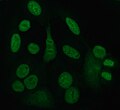Antinuclear antibody
Antinuclear_antibody[edit]
-
Main antinuclear antibody patterns on immunofluorescence
-
DsDNA antibodies
-
SSA SSB ANA
-
ANA - dsDNA antibody
-
Centromere
-
ANA Kit
-
ANA Immunofluorescence
-
ANA Nucleolar
-
Crithidia
-
LE Cell
Antinuclear Antibody[edit]
Antinuclear antibodies (ANAs) are autoantibodies that bind to contents of the cell nucleus. They are often found in patients with autoimmune diseases, but can also be present in healthy individuals. ANAs are a hallmark of systemic lupus erythematosus (SLE) and are also associated with other autoimmune conditions such as rheumatoid arthritis, scleroderma, and Sjogren's syndrome.
Structure and Function[edit]
Antinuclear antibodies target various nuclear components, including DNA, RNA, and nuclear proteins. These antibodies can be directed against specific nuclear antigens such as histones, ribonucleoproteins, and centromeres. The presence of ANAs can lead to the formation of immune complexes that deposit in tissues, causing inflammation and damage.
Clinical Significance[edit]
The presence of ANAs is a key diagnostic marker for autoimmune diseases. The antinuclear antibody test is commonly used to screen for autoimmune disorders. A positive ANA test indicates the presence of these antibodies, but it is not specific to any one disease. Therefore, further testing is often required to determine the specific type of autoimmune disorder.
Systemic Lupus Erythematosus[edit]
In SLE, ANAs are present in more than 95% of patients. The most common pattern seen in ANA testing for SLE is the homogeneous pattern, which indicates antibodies against double-stranded DNA and histones.
Other Autoimmune Diseases[edit]
ANAs are also found in other autoimmune diseases. In scleroderma, ANAs may show a nucleolar pattern, while in Sjogren's syndrome, they may show a speckled pattern. In rheumatoid arthritis, ANAs are less common but can still be present.
Testing and Interpretation[edit]
The ANA test is performed using immunofluorescence or enzyme-linked immunosorbent assay (ELISA). The immunofluorescence method involves incubating patient serum with cells fixed on a slide and then using a fluorescent dye to detect bound antibodies. The pattern and intensity of fluorescence are used to interpret the results.
Patterns[edit]
Different staining patterns can be observed in ANA testing, including homogeneous, speckled, nucleolar, and centromere patterns. Each pattern can be associated with different types of autoantibodies and diseases.
Titer[edit]
The ANA titer is a measure of the concentration of antinuclear antibodies in the blood. A higher titer indicates a greater concentration of antibodies. Titers are reported as ratios, such as 1:160 or 1:320, with higher numbers indicating higher levels of antibodies.
Related Pages[edit]
- Autoimmune disease
- Systemic lupus erythematosus
- Rheumatoid arthritis
- Scleroderma
- Sjogren's syndrome
- Immunofluorescence
| Hypersensitivity and autoimmune diseases (279.5–6) | ||||||||||||||||
|---|---|---|---|---|---|---|---|---|---|---|---|---|---|---|---|---|
|
Ad. Transform your life with W8MD's Budget GLP-1 injections from $75


W8MD offers a medical weight loss program to lose weight in Philadelphia. Our physician-supervised medical weight loss provides:
- Weight loss injections in NYC (generic and brand names):
- Zepbound / Mounjaro, Wegovy / Ozempic, Saxenda
- Most insurances accepted or discounted self-pay rates. We will obtain insurance prior authorizations if needed.
- Generic GLP1 weight loss injections from $75 for the starting dose.
- Also offer prescription weight loss medications including Phentermine, Qsymia, Diethylpropion, Contrave etc.
NYC weight loss doctor appointmentsNYC weight loss doctor appointments
Start your NYC weight loss journey today at our NYC medical weight loss and Philadelphia medical weight loss clinics.
- Call 718-946-5500 to lose weight in NYC or for medical weight loss in Philadelphia 215-676-2334.
- Tags:NYC medical weight loss, Philadelphia lose weight Zepbound NYC, Budget GLP1 weight loss injections, Wegovy Philadelphia, Wegovy NYC, Philadelphia medical weight loss, Brookly weight loss and Wegovy NYC
|
WikiMD's Wellness Encyclopedia |
| Let Food Be Thy Medicine Medicine Thy Food - Hippocrates |
Medical Disclaimer: WikiMD is not a substitute for professional medical advice. The information on WikiMD is provided as an information resource only, may be incorrect, outdated or misleading, and is not to be used or relied on for any diagnostic or treatment purposes. Please consult your health care provider before making any healthcare decisions or for guidance about a specific medical condition. WikiMD expressly disclaims responsibility, and shall have no liability, for any damages, loss, injury, or liability whatsoever suffered as a result of your reliance on the information contained in this site. By visiting this site you agree to the foregoing terms and conditions, which may from time to time be changed or supplemented by WikiMD. If you do not agree to the foregoing terms and conditions, you should not enter or use this site. See full disclaimer.
Credits:Most images are courtesy of Wikimedia commons, and templates, categories Wikipedia, licensed under CC BY SA or similar.
Translate this page: - East Asian
中文,
日本,
한국어,
South Asian
हिन्दी,
தமிழ்,
తెలుగు,
Urdu,
ಕನ್ನಡ,
Southeast Asian
Indonesian,
Vietnamese,
Thai,
မြန်မာဘာသာ,
বাংলা
European
español,
Deutsch,
français,
Greek,
português do Brasil,
polski,
română,
русский,
Nederlands,
norsk,
svenska,
suomi,
Italian
Middle Eastern & African
عربى,
Turkish,
Persian,
Hebrew,
Afrikaans,
isiZulu,
Kiswahili,
Other
Bulgarian,
Hungarian,
Czech,
Swedish,
മലയാളം,
मराठी,
ਪੰਜਾਬੀ,
ગુજરાતી,
Portuguese,
Ukrainian









